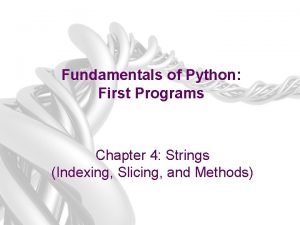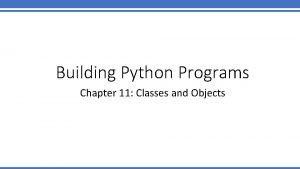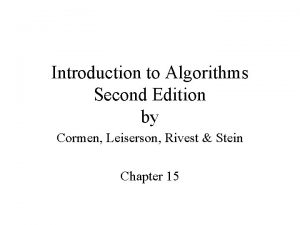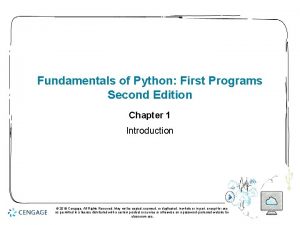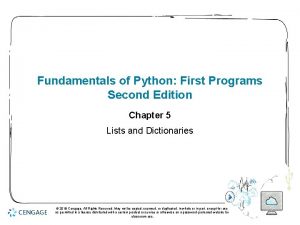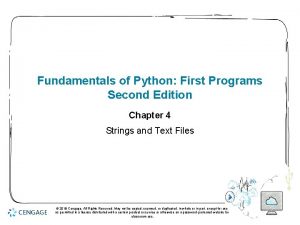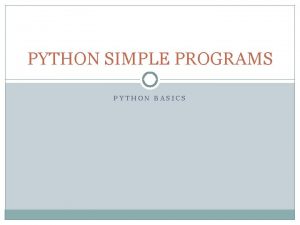Fundamentals of Python First Programs Second Edition Chapter









































- Slides: 41

Fundamentals of Python: First Programs Second Edition Chapter 10 Multithreading, Networks, and Client Server Programming © 2018 Cengage. All Rights Reserved. May not be copied, scanned, or duplicated, in whole or in part, except for use as permitted in a license distributed with a certain product or service or otherwise on a password-protected website for classroom use.

Objectives (1 of 2) 10. 1 Describe what threads do and how they are manipulated in an application 10. 2 Code an algorithm to run as a thread 10. 3 Use conditions to solve a simple synchronization problem with threads © 2018 Cengage. May not be copied, scanned, or duplicated, in whole or in part, except for use as permitted in a license distributed with a certain product or service or otherwise on a password-protected website for classroom use.

Objectives (2 of 2) 10. 4 Use IP addresses, ports, and sockets to create a simple client/server application on a network 10. 5 Decompose a server application with threads to handle client requests efficiently 10. 6 Restructure existing applications for deployment as client/server applications on a network © 2018 Cengage. May not be copied, scanned, or duplicated, in whole or in part, except for use as permitted in a license distributed with a certain product or service or otherwise on a password-protected website for classroom use.

Threads and Processes • Time-sharing systems (late 1950 s – early 1960 s) • Allowed several programs to run concurrently on a single computer • Multiprocessing systems (1980 s) • A single user running several programs at once • Networked/distributed systems (1980 s – 1990 s) • Processes began to be distributed across several CPUs linked by high-speed communication lines • Parallel systems • Run a single program on several CPUs at once © 2018 Cengage. All Rights Reserved. May not be copied, scanned, or duplicated, in whole or in part, except for use as permitted in a license distributed with a certain product or service or otherwise on a password-protected website for classroom use. 4

Threads (1 of 5) • In Python, a thread is an object like any other in that it can hold data, be run with methods, be stored in data structures, and be passed as parameters to methods • A thread can also be executed as a process • Before it can execute, a thread’s class must implement a run method • During its lifetime, a thread can be in various states © 2018 Cengage. All Rights Reserved. May not be copied, scanned, or duplicated, in whole or in part, except for use as permitted in a license distributed with a certain product or service or otherwise on a password-protected website for classroom use. 5

Threads (2 of 5) © 2018 Cengage. All Rights Reserved. May not be copied, scanned, or duplicated, in whole or in part, except for use as permitted in a license distributed with a certain product or service or otherwise on a password-protected website for classroom use. 6

Threads (3 of 5) • A thread remains inactive until start method runs • Thread is placed in the ready queue • Newly started thread’s run method is also activated • A thread can lose access to the CPU: • • Time-out (process also known as time slicing) Sleep Block Wait • Process of saving/restoring a thread’s state is called a context switch © 2018 Cengage. All Rights Reserved. May not be copied, scanned, or duplicated, in whole or in part, except for use as permitted in a license distributed with a certain product or service or otherwise on a password-protected website for classroom use. 7

Threads (4 of 5) • Most common way to create a thread is to define a class that extends the class threading. Thread from threading import Thread class My. Thread (Thread): “““A thread that prints its name. ””” def __init__(self, name): Thread. __init__(self, name = name) def run(self): print(“Hello, my name is %s" % self. get. Name()) >>> process = My. Thread(“Ken”) >>> process. start() Hello, my name is Ken © 2018 Cengage. All Rights Reserved. May not be copied, scanned, or duplicated, in whole or in part, except for use as permitted in a license distributed with a certain product or service or otherwise on a password-protected website for classroom use. 8

Threads (5 of 5) Thread Method What It Does __init__(name = None) Initializes the thread’s name get. Name() Returns the thread’s name set. Name(new. Name) Sets the thread’s name to new. Name run() Executes when the thread acquires the CPU start() Makes the new thready and raises an exception if run more than once is. Alive() Returns True if the thread is alive or False otherwise © 2018 Cengage. All Rights Reserved. May not be copied, scanned, or duplicated, in whole or in part, except for use as permitted in a license distributed with a certain product or service or otherwise on a password-protected website for classroom use. 9

Sleeping Threads • The function time. sleep puts a thread to sleep for the specified number of seconds © 2018 Cengage. All Rights Reserved. May not be copied, scanned, or duplicated, in whole or in part, except for use as permitted in a license distributed with a certain product or service or otherwise on a password-protected website for classroom use. 10

Producer, Consumer, and Synchronization (1 of 8) • Threads that interact by sharing data are said to have a producer/consumer relationship • Example: an assembly line in a factory • A producer must produce each item before a consumer consumes it • Each item must be consumed before the producer produces the next item • A consumer must consume each item just once • We will simulate a producer/consumer relationship: • Will share a single data cell with an integer © 2018 Cengage. All Rights Reserved. May not be copied, scanned, or duplicated, in whole or in part, except for use as permitted in a license distributed with a certain product or service or otherwise on a password-protected website for classroom use. 11

Producer, Consumer, and Synchronization (2 of 8) © 2018 Cengage. All Rights Reserved. May not be copied, scanned, or duplicated, in whole or in part, except for use as permitted in a license distributed with a certain product or service or otherwise on a password-protected website for classroom use. 12

Producer, Consumer, and Synchronization (3 of 8) Class or Function Role and Responsibility main Manages the user interface. Creates the shared cell and producer and consumer threads and starts the threads Shared. Cell Represents the shared data, which is an integer (initially -1) Producer Represents the producer process. Repeatedly writes an integer to the cell and increments the integer, until it reaches an upper bound. Consumer Represents the consumer process. Repeatedly reads an integer from the cell, until it reaches an upper bound. © 2018 Cengage. All Rights Reserved. May not be copied, scanned, or duplicated, in whole or in part, except for use as permitted in a license distributed with a certain product or service or otherwise on a password-protected website for classroom use. 13

Producer, Consumer, and Synchronization (4 of 8) class Producer(Thread): “““A producer of data in a shared cell. ””” def __init__(self, cell, access. Count, sleep. Max): “““Create a producer with the given shared cell, number of accesses, and maximum sleep interval. ””” Thread. __init__(self, name = “Producer”) self. access. Count = access. Count self. cell = cell self. sleep. Max = sleep. Max def run(self): “““Announce start-up, sleep and write to shared cell the given number of times, and announce completion. ””” print(“%s starting up” % self. get. Name()) for count in range(self. access. Count): time. sleep(random. randint(1, self. sleep. Max)) self. cell. set. Data(count + 1) print(“%s is done producingn” % self. get. Name()) © 2018 Cengage. All Rights Reserved. May not be copied, scanned, or duplicated, in whole or in part, except for use as permitted in a license distributed with a certain product or service or otherwise on a password-protected website for classroom use. 14

Producer, Consumer, and Synchronization (5 of 8) class Consumer(Thread): “““A consumer of data in a shared cell. ””” def __init__(self, cell, access. Count, sleep. Max): “““Create a consumer with the given shared cell, number of accesses, and maximum sleep interval. ””” Thread. __init__(self, name = “Consumer”) self. access. Count = access. Count self. cell = cell self. sleep. Max = sleep. Max def run(self): “““Announce start-up, sleep, and read from shared cell the given number of times, and announce completion. ””” print("%s starting up" % self. get. Name()) for count in range(self. access. Count): time. sleep(random. randint(1, self. sleep. Max)) value = self. cell. get. Data() print(“%s is done consumingn” % self. get. Name()) © 2018 Cengage. All Rights Reserved. May not be copied, scanned, or duplicated, in whole or in part, except for use as permitted in a license distributed with a certain product or service or otherwise on a password-protected website for classroom use. 15

Producer, Consumer, and Synchronization (6 of 8) • Synchronization problems may arise: • Consumer accesses the shared cell before the producer has written its first datum • Producer then writes two consecutive data (1 and 2) before the consumer has accessed the cell again • Consumer accesses data 2 twice • Producer writes data 4 after consumer is finished • Solution: synchronize producer/consumer threads • States of shared cell: writeable or not writeable • Add two instance variables to Shared. Cell: a Boolean flag (_writeable) and an instance of threading. Condition © 2018 Cengage. All Rights Reserved. May not be copied, scanned, or duplicated, in whole or in part, except for use as permitted in a license distributed with a certain product or service or otherwise on a password-protected website for classroom use. 16

Producer, Consumer, and Synchronization (7 of 8) • A Condition maintains a lock on a resource • Pattern for accessing a resource with a lock: Run acquire on the condition While it's not OK to do the work Run wait on the condition Do the work with the resource Run notify on the condition Run release on the condition © 2018 Cengage. All Rights Reserved. May not be copied, scanned, or duplicated, in whole or in part, except for use as permitted in a license distributed with a certain product or service or otherwise on a password-protected website for classroom use. 17

Producer, Consumer, and Synchronization (8 of 8) Condition Method What It Does acquire() Attempts to acquire the lock. Blocks if the lock is already taken. release() Relinquishes the lock, leaving it to be acquired by others. wait() Releases the lock, blocks the current thread until another thread calls notify or notify. All on the same condition, and then reacquires the lock. notify() Lets the next thread waiting on the lock know that it’s available notify. All() Lets all threads waiting on the lock know that it’s available © 2018 Cengage. All Rights Reserved. May not be copied, scanned, or duplicated, in whole or in part, except for use as permitted in a license distributed with a certain product or service or otherwise on a password-protected website for classroom use. 18

The Readers and Writers Problem (1 of 2) • Readers access the data to observe it • Writers access the data to modify it • Only one writer can be writing at a given time, and that writer must be able to finish before other writers or readers can begin writing or reading • Multiple readers can read the shared data concurrently without waiting for each other to finish, but all active readers must finish before a writer starts writing © 2018 Cengage. All Rights Reserved. May not be copied, scanned, or duplicated, in whole or in part, except for use as permitted in a license distributed with a certain product or service or otherwise on a password-protected website for classroom use. 19

The Readers and Writers Problem (2 of 2) • A solution to the readers and writers problem: • Encase the shared data in a shared cell object, with a locking mechanism to synchronize access for multiple readers and writers Shared. Cell Method What It Does Shared. Cell(data) Constructor, creates a shared cell containing data read(reader. Function) Applies reader. Function to the cell’s shared data in a critical section. reader. Function must be a function of one argument, which is of the same type as the shared data write(writer. Function) Applies writer. Function to the cell’s shared data in a critical section. writer. Function must be a function of one argument, which is of the same type as the shared data © 2018 Cengage. All Rights Reserved. May not be copied, scanned, or duplicated, in whole or in part, except for use as permitted in a license distributed with a certain product or service or otherwise on a password-protected website for classroom use. 20

Using the Shared. Cell Class • We create a shared cell containing a Savings. Account object for • multiple readers and writers, as follows: account = Savings. Account(name = "Ken", balance = 100. 00) cell = Shared. Cell(account) • Then at some point, a reader could run the code print(“The account balance is ”, cell. read(lambda account: account. get. Balance())) • to display the account’s balance. A writer could run the code amount = 200. 00 cell. write(lambda account: account. deposit(amount)) • to deposit $200. 00 into the account. © 2018 Cengage. All Rights Reserved. May not be copied, scanned, or duplicated, in whole or in part, except for use as permitted in a license distributed with a certain product or service or otherwise on a password-protected website for classroom use. 21

Implementing the Interface of the Shared. Cell Class class Shared. Cell(object): “““Synchronizes readers and writers around shared data, to support thread-safe reading and writing. ””” def __init__(self, data): “““Sets up the conditions and the count of active readers. ””” self. data = data self. writing = False self. reader. Count = 0 self. ok. To. Read = Condition() self. ok. To. Write = Condition() © 2018 Cengage. All Rights Reserved. May not be copied, scanned, or duplicated, in whole or in part, except for use as permitted in a license distributed with a certain product or service or otherwise on a password-protected website for classroom use. 22

Implementing the Helper Methods of the Shared. Cell Class (1 of 2) • In begin. Read, the reader thread must wait on its condition if a writer is currently writing or writers are waiting on their condition def begin. Read(self): “““Waits until a writer is not writing or the writers condition queue is empty. Then increments the reader count and notifies the next waiting reader. ””” self. ok. To. Read. acquire() self. ok. To. Write. acquire() while self. writing or len(self. ok. To. Write. _waiters) > 0: self. ok. To. Read. wait() self. reader. Count += 1 self. ok. To. Read. notify() © 2018 Cengage. All Rights Reserved. May not be copied, scanned, or duplicated, in whole or in part, except for use as permitted in a license distributed with a certain product or service or otherwise on a password-protected website for classroom use. 23

Implementing the Helper Methods of the Shared. Cell Class (2 of 2) • When a reader is finished in its critical section, the method end. Read decrements the count of active readers • It then notifies the next waiting writer, if there are no active readers: def end. Read(self): “““Notifies a waiting writer if there are no active readers. ””” self. reader. Count −= 1 if self. reader. Count == 0: self. ok. To. Write. notify() self. ok. To. Write. release() self. ok. To. Read. release() © 2018 Cengage. All Rights Reserved. May not be copied, scanned, or duplicated, in whole or in part, except for use as permitted in a license distributed with a certain product or service or otherwise on a password-protected website for classroom use. 24

Testing the Shared. Cell Class with a Counter Object © 2018 Cengage. All Rights Reserved. May not be copied, scanned, or duplicated, in whole or in part, except for use as permitted in a license distributed with a certain product or service or otherwise on a password-protected website for classroom use. 25

Defining a Thread-Safe Class • Decorator pattern • define a new class that has the same interface or set of methods as the class that it “decorates” • Programmers can substitute objects of this new class wherever they have used objects of the decorated class © 2018 Cengage. All Rights Reserved. May not be copied, scanned, or duplicated, in whole or in part, except for use as permitted in a license distributed with a certain product or service or otherwise on a password-protected website for classroom use. 26

Networks, Clients, and Servers • Clients and servers are applications or processes that can run locally on a single computer or remotely across a network of computers • The resources required for this type of application are: • IP addresses • Sockets • Threads © 2018 Cengage. All Rights Reserved. May not be copied, scanned, or duplicated, in whole or in part, except for use as permitted in a license distributed with a certain product or service or otherwise on a password-protected website for classroom use. 27

IP Addresses (1 of 3) • A computer on a network has a unique identifier called an IP address (IP: Internet Protocol) • Can be specified as an IP number - Format: ddd (d is a digit) - Example: 137. 112. 194. 77 • Or, as an IP name - Example: lambertk • Python’s socket module includes two functions that can look up these items of information © 2018 Cengage. All Rights Reserved. May not be copied, scanned, or duplicated, in whole or in part, except for use as permitted in a license distributed with a certain product or service or otherwise on a password-protected website for classroom use. 28

IP Addresses (2 of 3) socket Function What It Does gethostname() Returns the IP name of the host computer running the Python interpreter. Raises an exception if the computer does not have an IP address. gethostbyname(ip. Name) Returns the IP number of the computer whose I P name is ip. Name. Raises an exception if ip. Name cannot be found. © 2018 Cengage. All Rights Reserved. May not be copied, scanned, or duplicated, in whole or in part, except for use as permitted in a license distributed with a certain product or service or otherwise on a password-protected website for classroom use. 29

IP Addresses (3 of 3) >>> from socket import * >>> gethostname() ‘kenneth-lamberts-powerbook-g 4 -15. local’ >>> gethostbyname(gethostname()) ‘ 193. 169. 1. 209’ >>> gethostbyname(“Ken”) Traceback (most recent call last): File “<pyshell#7>”, line 1, in <module> gethostbyname('Ken') gaierror: (7, ‘No address associated with nodename’) try: print(gethostbyname(‘Ken’)) except Exception as exception: print(exception) © 2018 Cengage. All Rights Reserved. May not be copied, scanned, or duplicated, in whole or in part, except for use as permitted in a license distributed with a certain product or service or otherwise on a password-protected website for classroom use. 30

Ports, Servers, and Clients • Clients connect to servers via ports • Serve as a channel through which several clients can exchange data with the same server or with different servers • Usually specified by numbers • Some are dedicated to special servers or tasks - Example: 13 for the day/time server or 80 for a Web server • Most computers also have hundreds or even thousands of free ports available for use by any network applications © 2018 Cengage. All Rights Reserved. May not be copied, scanned, or duplicated, in whole or in part, except for use as permitted in a license distributed with a certain product or service or otherwise on a password-protected website for classroom use. 31

Sockets and a Day/Time Client Script (1 of 2) • We’ll write a script that is a client to a server • Socket: object that serves as a communication link between a server process and a client process • Can create/open several sockets on the same port © 2018 Cengage. All Rights Reserved. May not be copied, scanned, or duplicated, in whole or in part, except for use as permitted in a license distributed with a certain product or service or otherwise on a password-protected website for classroom use. 32

Sockets and a Day/Time Client Script (2 of 2) © 2018 Cengage. All Rights Reserved. May not be copied, scanned, or duplicated, in whole or in part, except for use as permitted in a license distributed with a certain product or service or otherwise on a password-protected website for classroom use. 33

A Day/Time Server Script (1 of 3) • You can write a day/time server script in Python to handle requests from many clients • The basic sequence of operations for a simple day/time server script is: Create a socket and open it on port 5000 of the local host While true: Wait for a connection from a client When the connection is made, send the date to the client © 2018 Cengage. All Rights Reserved. May not be copied, scanned, or duplicated, in whole or in part, except for use as permitted in a license distributed with a certain product or service or otherwise on a password-protected website for classroom use. 34

A Day/Time Server Script (2 of 3) © 2018 Cengage. All Rights Reserved. May not be copied, scanned, or duplicated, in whole or in part, except for use as permitted in a license distributed with a certain product or service or otherwise on a password-protected website for classroom use. 35

A Day/Time Server Script (3 of 3) “““ Server for providing the day and time. ””” from socket import * from time import ctime HOST = “localhost” PORT = 5000 ADDRESS = (HOST, PORT) server = socket(AF_INET, SOCK_STREAM) server. bind(ADDRESS) server. listen(5) while True: print(“Waiting for connection. . . ”) (client, address) = server. accept() print(“. . . connected from: ”, address) client. send(bytes(ctime() + “n. Have a nice day!”, “asci”)) client. close() © 2018 Cengage. All Rights Reserved. May not be copied, scanned, or duplicated, in whole or in part, except for use as permitted in a license distributed with a certain product or service or otherwise on a password-protected website for classroom use. 36

A Two-Way Chat Script (1 of 2) • Server creates a socket and enters an infinite loop to accept/handle clients; when one connects, it sends a greeting, and enters loop to chat with client while True: print(“Waiting for connection. . . ”) client, address = server. accept() print(“. . . connected from: ”, address) client. send(bytes(“Welcome to my chat room!”, CODE)) while True: message = decode(client. recv(BUFSIZE), CODE) if not message: print(“Client disconnected”) client. close() break else: print(message) client. send(bytes(input(“> ”), CODE) © 2018 Cengage. All Rights Reserved. May not be copied, scanned, or duplicated, in whole or in part, except for use as permitted in a license distributed with a certain product or service or otherwise on a password-protected website for classroom use. 37

A Two-Way Chat Script (2 of 2) • Client: • Sets up a socket • After connection, receives and displays greeting, then, enters a loop to chat with server print(decode(server. recv(BUFSIZE), CODE)) while True: message = input(“> ”) if not message: break server. send(bytes(message, CODE)) reply = decode(server. recv(BUFSIZE), CODE) if not reply: print(“Server disconnected”) break print(reply) server. close() © 2018 Cengage. All Rights Reserved. May not be copied, scanned, or duplicated, in whole or in part, except for use as permitted in a license distributed with a certain product or service or otherwise on a password-protected website for classroom use. 38

Handling Multiple Clients Concurrently • To solve the problem of giving many clients timely access to the server, we assign task of handling the client’s request a client-handler thread © 2018 Cengage. All Rights Reserved. May not be copied, scanned, or duplicated, in whole or in part, except for use as permitted in a license distributed with a certain product or service or otherwise on a password-protected website for classroom use. 39

Chapter Summary (1 of 2) • Thread synchronization problems can occur when two or more threads share data • Each computer on a network has a unique IP address that allows other computers to locate it • Servers and clients communicate on a network by sending bytes through their socket connections • A server can handle several clients concurrently by assigning each client request to a separate handler thread © 2018 Cengage. All Rights Reserved. May not be copied, scanned, or duplicated, in whole or in part, except for use as permitted in a license distributed with a certain product or service or otherwise on a password-protected website for classroom use. 40

Chapter Summary (2 of 2) • A class variable is a name for a value that all instances of a class share in common • Pickling is the process of converting an object to a form that can be saved to permanent file storage • try-except statement is used to catch and handle exceptions • Most important features of OO programming: encapsulation, inheritance, and polymorphism • Encapsulation restricts access to an object’s data to users of the methods of its class • Inheritance allows one class to pick up the attributes and behavior of another class for free • Polymorphism allows methods in several different classes to have the same headers • A data model is a set of classes that are responsible for managing the data of a program © 2018 Cengage. All Rights Reserved. May not be copied, scanned, or duplicated, in whole or in part, except for use as permitted in a license distributed with a certain product or service or otherwise on a password-protected website for classroom use. 41
 Python subscript operator
Python subscript operator Fundamentals of python: first programs
Fundamentals of python: first programs Disadvantages of waterfall model in software engineering
Disadvantages of waterfall model in software engineering Python about
Python about Building python programs
Building python programs Point class
Point class Fundamentals of information systems 9th edition
Fundamentals of information systems 9th edition Fundamentals of information systems 9th edition
Fundamentals of information systems 9th edition Fluid mechanics fundamentals and applications
Fluid mechanics fundamentals and applications Digital fundamentals floyd 10th edition
Digital fundamentals floyd 10th edition Machining fundamentals 10th edition
Machining fundamentals 10th edition Fundamentals of organizational communication 9th edition
Fundamentals of organizational communication 9th edition Fundamentals of organizational communication 9th edition
Fundamentals of organizational communication 9th edition Fundamentals of corporate finance, third canadian edition
Fundamentals of corporate finance, third canadian edition Digital fundamentals floyd 10th edition
Digital fundamentals floyd 10th edition Digital fundamentals by floyd
Digital fundamentals by floyd Electronics fundamentals a systems approach
Electronics fundamentals a systems approach Computer security fundamentals 4th edition
Computer security fundamentals 4th edition Management fundamentals 8th edition
Management fundamentals 8th edition Fundamentals of information systems 9th edition
Fundamentals of information systems 9th edition Fundamentals of corporate finance canadian edition
Fundamentals of corporate finance canadian edition Fundamentals of corporate finance fifth edition
Fundamentals of corporate finance fifth edition Corporate finance 6th edition
Corporate finance 6th edition Abnormal psychology comer 9th edition
Abnormal psychology comer 9th edition Fundamentals of information systems 9th edition
Fundamentals of information systems 9th edition Thermal resistance formula
Thermal resistance formula The fundamentals of political science research 2nd edition
The fundamentals of political science research 2nd edition Fundamentals of python data structures
Fundamentals of python data structures 186 282 miles per second into meters per second
186 282 miles per second into meters per second Advanced word power second edition answers
Advanced word power second edition answers Accounting principles second canadian edition
Accounting principles second canadian edition Accounting principles second canadian edition
Accounting principles second canadian edition Accounting principles second canadian edition
Accounting principles second canadian edition Clear thinking and writing answer key
Clear thinking and writing answer key Accounting principles second canadian edition
Accounting principles second canadian edition Kaufman test of educational achievement
Kaufman test of educational achievement Introduction to algorithms 2nd ed
Introduction to algorithms 2nd ed In company second edition
In company second edition Wechsler individual achievement test second edition
Wechsler individual achievement test second edition Ten steps to advanced reading answer key
Ten steps to advanced reading answer key Organic chemistry
Organic chemistry Using mis (10th edition) 10th edition
Using mis (10th edition) 10th edition
